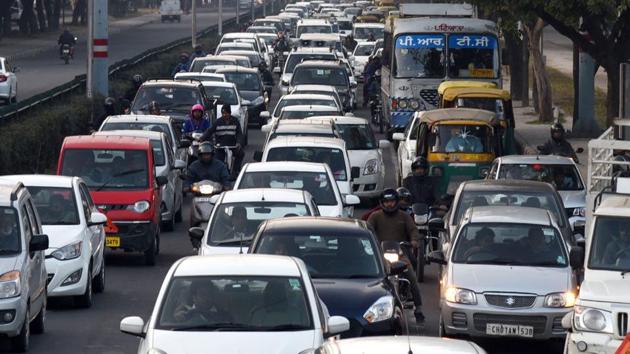Vehicular density linked to rise in nitrogen oxide levels in Chandigarh: Study
More vehicles on roads mean higher concentration of toxic gases, states a study by the Post Graduate Institute of Medical Education and Research
Nitrogen oxide (NOx) levels are increasing in the city due to higher vehicular density, reveals a study by the Postgraduate Institute of Medical Education and Research (PGIMER) on air quality in the last 25 years.

NOx are a group of toxic gases that contribute to the formation of aerosols and ozone that can worsen respiratory conditions and cause other health problem.
The study showed a 68.2 % and 165.2% increase in NOx concentration at commercial and industrial sites, respectively, in 2018 as compared to 2000. This can be linked to increased vehicular emissions.
The study titled Air pollution trend in Chandigarh city situated in Indo-Gangetic Plains: Understanding seasonality and impact of mitigation strategies has been authored by Ravinder Khaiwal (department of community medicine and school of public health, PGIMER), Tanbir Singh and Suman Mor (department of environment studies, Panjab University) and Vivek Pandey (Chandigarh Pollution Control Committee).
Increasing trend at all locations
“As in the year 2011, vehicle number has increased by 270%. Similarly, the concentration of NOx is showing an increasing trend at all the locations in Chandigarh,” the study reads.
Chandigarh has the highest vehicular density (878 registered motor vehicles per thousand persons) in India due to which vehicular emissions can be considered as one of the primary sources of background air pollution here.
The study has also shown higher particulate matter (PM) 10 concentration (which are inhalable and hazardous to health) in winter as compared to monsoon as air quality deteriorates during December due to crop-residue burning and meteorology.
More pollution in winter
Winter of 2018 had the highest PM10 levels, and the concentration decreased by 28 to 47% during monsoon.
As per United Nations Environmental Protection Agency, “Breathing air with a high concentration of NO2 can irritate airways in the human respiratory system. Such exposures over short periods can aggravate respiratory diseases, particularly asthma, leading to respiratory symptoms (such as coughing, wheezing or difficulty breathing), hospital admissions and visits to emergency rooms.”
According to the study, air pollutants show strong seasonal variability having a higher concentration in post-monsoon and winter season, which was found to be linked with activities such as crop residue burning and use of solid biomass fuel for cooking and other purposes.
Besides, industrial and commercial sites show a statistically declining trend of PM10. In industrial areas, the reason could be attributed to stricter implementation of air pollution control policies. At commercial sites, moving of interstate bus terminals has restricted movement of diesel buses and cleaner air.
The study underlines the need for stringent action to control air pollution due to non-exhaust emissions, municipal solid waste, and crop residue burning to minimise public health and climate risk






